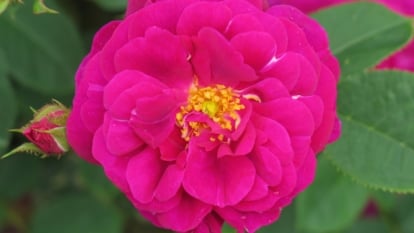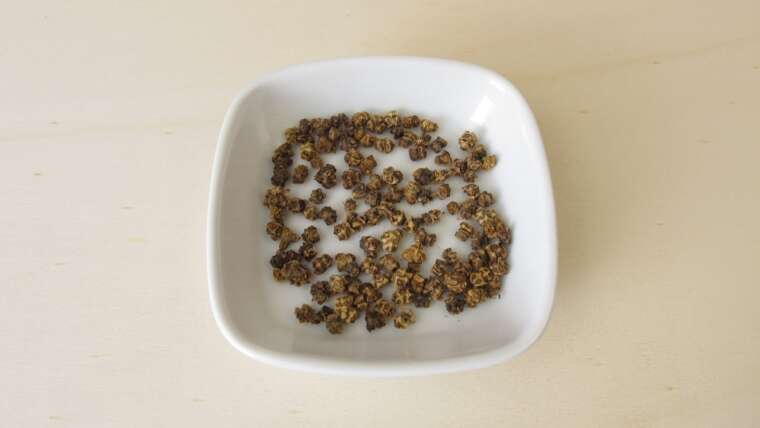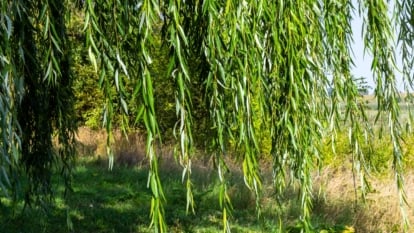Rosa ‘Henri Martin’ is a top specimen among old garden roses. This heirloom has crimson and magenta blooms, lush foliage, and an intoxicating fragrance. The nearly rounded flowers are semi-double and full of petals. ‘Henri Martin,’ also called ‘Red Moss’, features mossy-looking growth on stems and buds for added interest.
Beyond their aesthetic graces, old garden roses bring exceptional disease resistance and adaptability to the garden. ‘Henri Martin’ is a handsome, award-winning moss rose worthy of a spot in today’s mixed border, hedge, or as a single specimen shrub.
Overview
| | |
What are ‘Henri Martin’ Roses?
 An antique rose boasting deep crimson blooms and a classic fragrance.
An antique rose boasting deep crimson blooms and a classic fragrance.
Rosa ‘Henri Martin’ is an antique rose with petal-packed fuchsia to crimson blooms, attractive foliage, and high fragrance. Also called ‘Red Moss,’ it is a fine representation of the moss class of roses.
Moss roses feature pronounced growth along their stems and buds, creating a fuzzy, mossy effect. They are part of the Old Garden Rose distinction (roses dating before the 1867 introduction of the hybrid tea rose).
‘Henri Martin’ graces the garden with fully-petaled fuchsia blooms early in the summer. They boast an exceptional old rose fragrance, heady and a bit sweet in the classic perfume sense. Plants grow vigorously with adaptability, hardiness, and disease resistance and tolerate high heat and partial shade.
‘Henri Martin’ is a recipient of the Royal Horticultural Society’s Award of Garden Merit and an America Rose Society top selection among Old Garden Roses. It tolerates a range of growing conditions with a profusion of blooms.
Renowned 18th-century French breeder Jean Laffay introduced ‘Henri Martin’ in 1863. Laffay’s specialty was innovating hybrid perpetual, bourbon, and tea roses, among others, and is preeminent in creating plants with reblooming qualities and hardy performance.
‘Henri Martin’ is named after the French historian who wrote the comprehensive Histoire de France. Henri Martin was also instrumental in orchestrating the Statue of Liberty as a gift to the United States.
Characteristics
 Clusters of crimson blooms with lush foliage, attracting wildlife year-round.
Clusters of crimson blooms with lush foliage, attracting wildlife year-round.
‘Red Moss’ features nearly rounded rosettes with forty or more petals per flower. Flowers are crimson with magenta tones and age to purple-red. ‘Henri Martin’ is a single-season bloomer that produces a wonderful flush of clustered flowers from late spring to early summer.
Long, mossy green buds add interest and open to reveal vibrant blooms. Stems, sepals, and buds have a fuzzy coating created by glandular growth projections forming mossy coverage. The stems and buds have a pine or peppery apple scent, sometimes fruity, depending on the beholder. In flower, the old rose fragrance steals the show.
‘Henri Martin’ features exceptional foliage, which is dense and dark. Toothed leaves in deep green are leathery and full along thorny stems.
These fast-growing shrubs reach five to six feet tall with a spread of four feet in two to five years. ‘Henri Martin’ grows beautifully as a specimen shrub or part of a hedge or mixed border. Its long stems benefit from support, like a trellis, or grow as a small climber when trained.
When ‘Red Moss’ flowers are fully open, bright yellow stamens attract pollinators. Red rose hips emerge as blooms fade, bringing lasting winter interest and food for birds and other wildlife.
Native Area
 These roses thrive in diverse conditions, from shade to drought.
These roses thrive in diverse conditions, from shade to drought.
Moss roses originate from European cultivation, with origins in the Middle-Eastern Damask roses and the European Centifolia (“cabbage” roses) of Gallica and Damask lineage. Derived from hardy species, ‘Henri Martin’ tolerates various light conditions, including partial shade. They also adapt to different soil conditions and periods of drought.
Planting
 For best results, provide adequate space and airflow for growth.
For best results, provide adequate space and airflow for growth.
‘Henri Martin’ is a tough old garden rose that grows in various situations. Plants need good air circulation to thrive. Leave ample space around each for airflow, mature growth, and spreading roots.
To avoid overcrowding, leave at least one foot between these shrubs and companion plantings and three to four feet between larger plants. If using a support structure to direct ‘Henri Martin’ growth, install the trellis at planting time to avoid disturbing roots in the future.
Transplanting
 Optimize planting conditions for robust establishment and growth.
Optimize planting conditions for robust establishment and growth.
It’s best to plant ‘Henri Martin’ in late winter, early spring, and fall, though you can plant them year-round. Spring and fall’s cool temperatures and seasonal moisture give plants time to establish before winter and summer temperature fluctuations. For the least stress on the new plant, avoid frozen or waterlogged conditions and extreme heat or drought periods.
For nursery potted and bare-root plants, dig a rugged, choppy hole six to eight inches larger than the root ball to loosen the surrounding soil and accommodate all the roots. Amend the native soil with compost and install the new or transplanted rose. Water the plants thoroughly to soak the roots and surrounding soil.
How to Grow
‘Red Moss’ is a carefree, unfussy grower as roses go. However, all roses benefit from certain growing conditions for optimal health and flowering.
Ensuring air circulation for plant vigor and health while preventing foliar diseases is essential to growing healthy plants.
Light
 Maximize sunlight for optimal growth and blooming.
Maximize sunlight for optimal growth and blooming.
‘Henri Martin’ grows best in full sun, where blooming and disease resistance improves. These old garden roses also grow in partial shade, with at least four hours of sun for best growth.
In hot summer climates, the plants benefit from morning sun exposure with protection from intense, direct afternoon rays.
Water
 Deep, weekly watering fosters healthy growth and blooms.
Deep, weekly watering fosters healthy growth and blooms.
‘Henri Martin’ benefits from regular, deep-watering sessions rather than frequent watering at shallower levels. During the growing season, provide one inch of water per week to soak soils, depending on rainfall. Ensure the soil stays evenly moist for newly planted roses until they establish.
Once established, ‘Henri Martin’ benefits from supplemental watering during dry spells, about one to two inches weekly. These roses are moderately drought-tolerant. Take care not to overwater or create soggy soils, as wet conditions lead to pest and disease issues.
All roses do best with watering early in the day, preferably at the ground level with drip irrigation, soaker hoses, or hose bubblers. Refraining from overhead watering helps prevent foliar diseases, especially by avoiding evening or nighttime sprinklers. Some gardeners do fine with overhead irrigation (admittedly, I do), making sure to water in the morning to give leaves time to dry in the sun.
Soil
 Prepare rich, well-draining soil with compost for optimal growth.
Prepare rich, well-draining soil with compost for optimal growth.
These adaptable plants grow in most soil types, from clay to loam to sand. They thrive in well-draining soils with even moisture and prefer rich, loose, neutral to slightly acidic soils.
Adding organic matter to the native soil is ideal. At planting, add three to six inches of compost from completely broken-down plant material, especially in poor soils like clay and sand. Compost will help with aeration, moisture retention, drainage, and nutrition.
Temperature and Humidity
 Shield plants from extreme temperatures with strategic mulching and ample spacing.
Shield plants from extreme temperatures with strategic mulching and ample spacing.
‘Henri Martin’ roses withstand hot summers in upper zones 8 and 9 and are winter hardy down to USDA zone 4. The best planting temperatures are between 40 and 60°F (4-16°C).
Mulching around plants helps regulate temperatures, keeping roots cool in the summer and providing insulation in the winter. In cold winter areas, protect the crowns for best overwintering.
In areas with high humidity, give ‘Henri Martin’ plenty of air circulation to combat damp conditions that promote pests and diseases. Ensure enough space around the plant and avoid overcrowding with other plants.
Fertilizing
 Old garden roses thrive with occasional balanced organic fertilization during growth.
Old garden roses thrive with occasional balanced organic fertilization during growth.
While old garden roses aren’t heavy feeders like modern types, they benefit from supplemental nutrition during the active growing and flowering period.
A balanced fertilizer in early spring ensures a vital growing season. Fish emulsion, seaweed extract, or an organic rose fertilizer are beneficial every six weeks (per label instructions) throughout the growing season.
Maintenance
 Insulate with mulch for moisture, warmth, and nutrient retention.
Insulate with mulch for moisture, warmth, and nutrient retention.
Old garden roses are among low-maintenance plants. Insulate them with a layer of mulch throughout the year, refreshing mulch in the spring before new growth emerges. Maintain a three-inch layer to retain moisture, regulate temperature, and suppress weeds. Mulch also adds nutrients to the soil as it breaks down.
Avoid deadheading spent blooms to achieve showy rosehips later in the season. ‘Henri Martin’ flowers once a season, and those blooms set hips for fall interest and wildlife forage.
Remove diseased leaves and any fallen leaves and flowers from around plants as part of regular maintenance. Removing dropped material promotes overall health by reducing the occurrence of pests and diseases.
These plants don’t require special pruning. As preventative maintenance, remove any crossed, diseased, or dead canes in late winter before spring buds appear.
Propagation
The easiest way to propagate ‘Red Moss’ is through softwood cuttings. The cuttings may take a few years to develop into full, multi-stemmed plants, but the cutting process is straightforward and rewarding.
Cuttings
 Create new plants easily with spring or fall cuttings for success.
Create new plants easily with spring or fall cuttings for success.
Propagate roses from cuttings in the spring or fall, and take multiple cuttings since not all may root. Here are guidelines for ‘Henri Martin’ softwood cuttings:
- Cut a length of healthy, green stem from the end of a cane into six-to-eight-inch pieces. Remove any flowers or hips down to the first layer of healthy leaves.
- Remove the foliage from the bottom ½ of the cutting, keeping any upper leaves intact. Keep cuttings moist until ready to pot.
- Optionally, moisten the cutting and dip the lower stem in rooting hormone, coating generously. Tap off any excess rooting powder.
- Stick the cutting at about half its length in a pot with moist, well-draining potting mix. Vermiculite and perlite make suitable mixtures.
- Place the pot in a bright, warm location out of direct sunlight.
- Water or mist the soil as needed to keep it evenly moist. When roots have taken hold and new growth emerges, transplant stems to a larger pot or into the garden to harden off. New plants will be tender.
Common Problems
Providing the appropriate cultural conditions is the first step to healthy and beautiful ‘Henri Martin’ shrubs. These plants have few problems, but as roses, black spot and powdery mildew aren’t uncommon diseases. Plants may also experience visits from aphids, scale, and spider mites. Rose Rosette disease can’t be ruled out either.
Planting in full sun with plenty of air circulation, especially in humid or wet conditions, and average moisture helps stave off infections. Pruning and removing diseased leaves helps prevent the spread of pests and most diseases.
To encourage natural garden pest control and biodiversity, consider companion plantings for roses, like lavender, catmint, allium, geranium, and agastache. These plants repel pests like aphids and attract beneficial predatory insects.
Pests
 Early detection and non-chemical methods effectively manage common garden pests.
Early detection and non-chemical methods effectively manage common garden pests.
The best way to control insects is to spot them early. You’ll likely see the insects themselves or notice yellowing, disfigured leaves or stunted growth.
Aphids, spider mites, and scales are common sap-sucking insects usually treated with non-chemical means. Often, they cause no significant damage, but severe infestations cause plant stress, such as curled leaves and disfigured blooms.
In the active growing season, spray the plant with a strong stream of water to deter and knock insects off the stems. Do this in the morning so leaves dry in the early sun. If an infestation occurs, a simple horticultural soap rids the plant of insects, but be sure to follow label directions, as these affect beneficial insects as well. Beneficial predatory insects like ladybugs and predatory mites help control populations.
Diseases
 Black spot fungus causes distinctive black spots on rose leaves.
Black spot fungus causes distinctive black spots on rose leaves.
Because ‘Henri Martin’ is an old garden rose, plants are better at shaking off diseases than many hybrids. Adequate sunlight, well-draining soils, and circulation promote vigorous plants.
Black spot is one of the most common diseases. The black spot fungus causes black spots with feathery margins on leaves and stems. Black spot occurs when leaves remain overly wet from overhead watering or periods of prolonged moisture. If spraying leaves with water to deter pests, do so in the morning when leaves will have time to dry in the sun.
Powdery mildew is another common fungal disease indicated by a gray-white powdery substance on leaves, stems, and buds. Leaves may distort and drop.
Horticultural oils like Neem preventatively treat black spot and powdery mildew. Before a spray treatment, try removing diseased leaves and plant parts from the plant and ground to prevent spread to healthy plant parts. Don’t spray leaves on a sunny day, as it may burn the foliage. Avoid spraying at all when pollinators are present.
While old garden roses aren’t as susceptible to rose rosette virus as multiflora roses, it is still possible that this deadly disease could affect your Henri Martin rose. Look out for red new growth that doesn’t turn green as it ages. Scout for extra-thorny new stems and deformed buds. If you see these signs, dig up the entire plant and burn it. Eriophyid mites spread the disease, so mite control is essential early in the season.
Frequently Asked Questions
‘Henri Martin’ is synonomous with ‘Red Moss’ and sometimes called ‘Old Red Moss.’ Moss roses have pronounced growth along stems and buds, giving plants a fuzzy coating and a mossy look. With its crimson blooms, the ‘Red Moss’ moniker followed. ‘Henri Martin’ is a Jean Laffay introduction (France, 1863) named for the eponymous French historian.
Old garden roses are a designation introduced before 1867 when the first hybrid tea rose entered the market. Gardeners prize them for their robust blooms, superior fragrance, attractive forms, and adaptability. Damasks, Gallicas, Albas, Centifolias, and Moss are the main OGR distinctions,
‘Henri Martin’ tolerates partial shade. While full sun (six hours or more) is best, dappled sunlight and afternoon shade don’t hamper it. Morning sun is ideal, with at least four hours of sun for best health.
Final Thoughts
Old garden roses bring history and effortless charm to the contemporary garden. Their exceptional flowering and fragrance, attractive foliage, and rugged nature entice us to expand our rose collection. And rightfully so – handsome specimens like the red moss ‘Henri Martin’ with fully petaled blooms, perfume, and dense leaves make a gorgeous addition.




